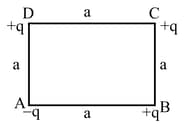Superposition Principle
Superposition Principle: Overview
This topic consists of various concepts like Force on a Charge Due to Two or More Charges,Superposition Principle,, etc.
Important Questions on Superposition Principle
In the two instances below, state whether electric field intensity and electric potential are zero or non-zero at the mid-point joining the two-point charges.

Three electric point charges and are at distances and respectively with respect to the same origin. What is the force on the charge in the field of charges and ?
Two charges of and are placed at the corners and of an equilateral triangle of side . The force on a charge of placed at is
Consider the charges , and placed at the vertices of an equilateral triangle, as shown in fig. What is the force on each charge?
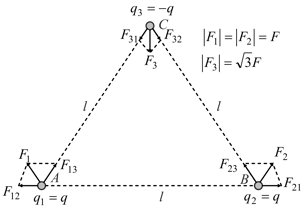
Three charges , and are placed on a straight line such that is somewhere in between and . If this system of charges is in equilibrium, what should be the magnitude and sign of charge ?
Find the resultant of two forces, one due east and other due to north.
Calculate the angle between a force and a So, that their resultant is .
Three particles, each of mass and carrying a charge each, are suspended from a common point by insulating massless strings, each of length . If the particles are in equilibrium and are located at the corners of an equilateral triangle of side , calculate the charge on each particle. Assume .
In the given figure calculate the resultant force on the charge if, is at the origin, charge is on the -axis at , and charge is at the point
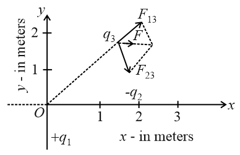
A particle having charge exerts electrostatic force on charge at rest. If a particle having charge is placed midway between the line joining the two charges and then electrostatic force on due to will become/remain
How can you find the force on any charge due to the other charges acting on it?
Explain the principle of superposition of charges in electrostatics.
Explain the superposition principle of forces for a charge. Does electric field obey superposition principle?
A hemisphere is uniformly charged positively. The electric field at a point on a diameter away from the centre is directed
Four point-charges are placed at the comers of a square of side as shown in the figure. The force on a charge of placed at the centre of square is
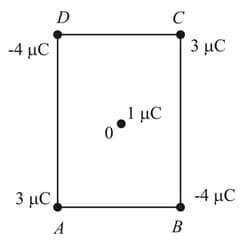
Three charges each of are placed at the corners of an equilateral triangle. If the force between any two charges be , then the net force on either charge will be:
Two identical positive charges are fixed at and A particle with negative charge starts from negative axis at a large distance from moves along the axis, passes through and moves far away from The particle's acceleration is is plotted against its coordinate. Which of the following best represents the plot?
Three large identical conducting sheets, each having a surface area of is placed parallel to each other at finite distance contain charges and . What is the magnitude of electric field at point?
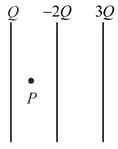
Which of the following figures correctly shows the top view sketch of the electric field lines for a uniformly charged hollow cylinder as shown in figure? 

